I fit a log-transformed linear mixed effect model and want to express the coefficients as percent change instead of linear change on the log scale in my summary table with sjPlot
Fake Data:
library(lme4)
library(lmerTest)
library(dplyr)
set.seed(1234)
dat_short <- data.frame(
dv = c(
# Add in t1 ctrl
rnorm(mean=0.8, sd=0.1, n=6), #Long Healthy
rnorm(mean=0.7, sd=0.1, n=6), #Lat Healthy
rnorm(mean=0.6, sd=0.1, n=4), #Long Damaged
rnorm(mean=0.5, sd=0.1, n=4), #Lat Damaged
# Add in t2 ctrl
rnorm(mean=0.7, sd=0.1, n=6), #Long Healthy
rnorm(mean=0.6, sd=0.1, n=6), #Lat Healthy
rnorm(mean=0.5, sd=0.1, n=4), #Long Damaged
rnorm(mean=0.4, sd=0.1, n=4), #Lat Damaged
# Add in t1 trt
rnorm(mean=0.8, sd=0.1, n=6), #Long Healthy
rnorm(mean=0.7, sd=0.1, n=6), #Lat Healthy
rnorm(mean=0.6, sd=0.15, n=4), #Long Damaged
rnorm(mean=0.5, sd=0.15, n=4), #Lat Damaged
# Add in t2 trt
rnorm(mean=0.7, sd=0.1, n=6), #Long Healthy
rnorm(mean=0.6, sd=0.1, n=6), #Lat Healthy
rnorm(mean=0.65, sd=0.15, n=4),#Long Damaged
rnorm(mean=0.55, sd=0.15, n=4) #Lat Damaged
),
id=c(rep(c("subj_1", "subj_2"), times=c(40, 40))),
intervention=c(rep(c("ctrl", "trt"), times=c(40, 40))),
timepoint=c(rep(rep(c("t1", "t2"), times=c(20, 20)),2)),
direction=c(rep(rep(c("long", "lat", "long", "lat"), times=c(6, 6, 4, 4)),4)),
region=c(rep(rep(c("healthy", "damaged"), times=c(12, 8)),4))
) |>
mutate(dv = case_when(
id == "subj_1" ~ dv + runif(1, min = 0.01, max = 0.2),
id == "subj_2" ~ dv))
speed_measures <-data.frame(
n_speed = c(
# Add in t1 ctrl
round(runif(8, min = 3, max =10),0)
),
id=c(rep(c("subj_1", "subj_2"), times=c(4, 4))),
timepoint=c(rep(rep(c("t1", "t2"), times=c(2, 2)),2)),
direction=c(rep(rep(c("long", "lat"), times=c(1, 1)))
))
dat_short_combined <- speed_measures |> left_join(dat_short) |> slice_sample(n = 70)
Fit the regression
lmm_1_short <- lmer(dv ~ intervention*timepoint*region + direction + (1|id), data=dat_short)
Summarize it nicely with sjPlot::tab_model, but this is linear change on the log scale, not as intuitive to understand
sjPlot::tab_model(lmm_1_short,
show.intercept = FALSE,
show.reflvl = TRUE,
show.obs = TRUE,
df.method = "satterthwaite")
So we can transform the coefficients to percent change:
# Transform regression coefficients to % change
lmm_1_short_perc_summary <- coef(lmm_1_short)$id |>
summarise(across(.fns = ~100*( exp(.x)-1) ) ) |>
summarise(across(.fns = ~mean(.x))) |>
select(-"(Intercept)") |>
tidyr::pivot_longer(cols = everything(), names_to="Coefficient", values_to = "% Change") |>
# Add p-values etc. from regression summary
cbind(coef(summary(lmm_1_short))[-1,-1]) |>
# Compute confidence intervals and transform those to % change as well
cbind(data.frame(confint(lmm_1_short))[4:11,]) |>
transmute(Coefficient, across(where(is.numeric), .fns = ~round(.x,3))) |>
rename("2.5% CI" = `X2.5..`, "97.5% CI" = `X97.5..`)
row.names(lmm_1_short_perc_summary) <- 1:nrow(lmm_1_short_perc_summary)
lmm_1_short_perc_summary
Which gives this nice summary:
So the goal is, make a pretty sjPlot style regression summary with my log -> % change transformation.
I tried to use the transform function in tab_model, to no avail. I assumed that sjPlot dragged in get_model_data early but really I have no idea.
function_test <- function(arg_1) {
sjPlot::get_model_data(arg_1, "est") |>
mutate(estimate = 100*( exp(estimate)-1) )
}
sjPlot::tab_model(lmm_1_short,
show.intercept = FALSE,
transform = "function_test",
show.reflvl = TRUE,
show.obs = TRUE,
df.method = "satterthwaite")
Error in if (fam.info$is_linear) transform <- NULL else transform <- "exp" :
argument is of length zero
Ref: https://cscu.cornell.edu/wp-content/uploads/83_logv.pdf


